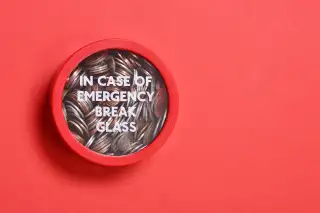Ask Yourself These Questions Before You Tap Your Emergency Fund

We all know the rules about emergency funds:
- You’re supposed to have one, and keep it separate from ordinary savings.
- Ideally, your fund should hold about three to six months’ worth of living expenses in case of a crisis.
- Or at the very least, you should stash $500 in there—as that will save your bacon more often than you’d think.
But when exactly should you let yourself spend that money? What constitutes an emergency, and what doesn’t?
That’s the key question, because when you’re in a pinch, as I am now, almost anything feels like a crisis.
Defining an emergency
An emergency fund is not your personal money piñata. You don’t get to crack it open for any seemingly urgent need. Because once you extract the goodies inside, it’s hard to stop yourself from using all the money.
Also, given the razor-like discipline it takes (some of us) to build up that reserve, you don’t want to touch it unless you absolutely have to. This is why many people say you mustn’t tap your stash except in the case of truly dire events: an illness, death or catastrophe.
Alas, that’s a tough standard for most of us, who typically face a rotating series of minor crises throughout the year—times when our fingers itch to log on to that protected account and click: transfer it all, right now!
When bad news hits your bank account
For example, what if you have to help an older relative move across the country? And what if you use your ordinary savings for those expenses—accidentally forgetting about the balance that’s now due for your kids' camp?
Or: what if your freelance husband’s paycheck gets derailed in the long, dark tunnels of corporate invoice approvals?
Or: What if you finally admit you need prescription glasses, since your health insurance supposedly covers them, you order the glasses, only to learn—embarrassingly, at the eyeglasses store—that you are on the hook for $602 out of pocket? Following that bad news, you get a $427 bill for the eye doctor visit, and you thought your health plan covered 100% of the appointment.
Saving secrets from a secret saver
Now, I wasn’t always a saver, but over the years I’ve learned to be quite a good one. I keep an underground network of special ops savings accounts at a bank that’s separate from our day-to-day checking account. In fact, for years, my husband didn’t even have the login info.
The special ops accounts are earmarked for the following: home and car repairs, vacation, gifts, curveballs, and our emergency fund. The curveball money is supposed to be for surprise expenses, like replacing a lost power cord, not a crisis.
I auto-transfer a bit into each account, every month. And while I like to believe that I use the gift funds for gifts, etc., what usually happens is there is a whopping blah-blah expense and I clear out whatever is available—without touching the emergency fund.
Well, it’s a groovy little system until you get one of those stretches where you can’t catch a break. That’s where we’re at now.
The cat threw up on my husband’s laptop ($1,500 to buy a new one); the car needed a whopping repair ($462); then the cat had to go to the vet ($540); I needed glasses (see above)—and last month we had to help my dad relocate from New Mexico back to New York City.
I think I deserve my own country music song right about now.
Which pot do you pick?
Still, you ask: Isn’t it wiser to use the cash in your emergency fund than put these expenses on an interest-bearing credit card?
People get strident about these sorts of dilemmas, but you have to think it through. This is not only about money—siphoning off cash vs. getting into debt—but where your psychological stress spots are. So ask yourself:
- Would it be easier for you to replenish the emergency fund, or pay off the credit card? My instinct is to protect the fund at all costs, because personally I find that’s harder to rebuild. But if your card carries a 19.9% interest rate, you don’t want to go there.
- Are you expecting any sort of windfall that could help you pay off the card relatively soon? Example: Thanks to the sale of my dad’s house, he can pay back some of the money we spent on his epic, cross-country move, so we put some moving expenses on our card.
- Can you split the difference, put some expenses on a card and use some emergency cash for the rest?
Whatever you do, never empty your emergency fund—for two reasons. First, leaving a cushion in there will give you some cash for the next asteroid that hits your life. Second, this may sound a bit Tinkerbell, but I’ve found it to be true: Keeping a chunk of money in the account mysteriously motivates you to help the fund grow.